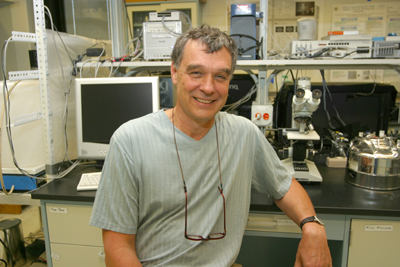Home > Press > Researchers develop better membranes for water treatment, drug delivery
 |
| U. of I. Photo
Mark Clark, a professor of civil and environmental engineering, and colleagues have developed a new generation of biomimetic membranes for water treatment and drug delivery. |
Abstract:
Researchers at the University of Illinois have developed a new generation of biomimetic membranes for water treatment and drug delivery. The highly permeable and selective membranes are based on the incorporation of the functional water channel protein Aquaporin Z into a novel A-B-A triblock copolymer.
Researchers develop better membranes for water treatment, drug delivery
CHAMPAIGN, IL | Posted on November 29th, 2007 The experimental membranes, currently in the form of vesicles, show significantly higher water transport than existing reverse-osmosis membranes used in water purification and desalination. The researchers describe their membranes in a paper accepted for publication in the Proceedings of the National Academy of Sciences. The paper is to be published in PNAS Online Early Edition this week.
"We took a close look at how kidneys so efficiently transport water through a membrane with aquaporins, and then we found a way to duplicate that in a synthetic system," said Manish Kumar, a graduate research assistant at the U. of I., and the paper's lead author.
Unlike most biological membranes, polymer membranes are very stable and can withstand considerable pressure - essential requirements for water purification and desalination processes. "Placing aquaporins in materials that we can use outside the body opens doors to industrial and municipal applications," Kumar said.
To make their protein-polymer membranes, the researchers begin with a polymer that self-assembles into hollow spheres called vesicles. While the polymer is assembling, the researchers add Aquaporin Z - a protein found in Escherichia coli bacteria.
"Aquaporin Z makes a hole in the membrane that only water can go through, so it's both fast and selective," said membrane specialist Mark Clark, a professor of civil and environmental engineering and one of the paper's co-authors.
"By varying the amount of Aquaporin Z, we can vary the membrane's permeability," Kumar said, "which could be very useful for drug-delivery applications."
With their high permeability and high selectivity, the biomimetic membranes also are ideal for water treatment by desalination, which is becoming increasingly important for water purification in semiarid coastal regions.
When tested, the productivity of the Aquaporin Z-incorporated polymer membranes was more than 10 times greater than other salt-rejecting polymeric membranes.
Currently, the experimental polymer membranes exist only as small vesicles. "Our next step is to convert the vesicles into larger, more practical membranes," Kumar said. "We also want to optimize the membranes for maximum permeability."
In addition to Clark and Kumar, co-authors of the paper are research professor Julie Zilles at the U. of I., and chemistry professor Wolfgang Meier and doctoral student Mariusz Grzelakowski, both at the University of Basel in Switzerland.
Funding was provided by the Swiss National Center of Competence in Nanoscale Science, the Swiss National Science Foundation and the University of Illinois.
####
About University of Illinois
At Illinois, research shapes the campus identity, stimulates classroom instruction and serves as a springboard for public engagement activities throughout the world. Opportunities abound for graduate students to develop independent projects and launch their own careers as researchers while working alongside faculty and assisting in their research. Illinois continues its long tradition of groundbreaking accomplishments with remarkable new discoveries and achievements that inspire and enrich the lives of people around the world.
For more information, please click here
Contacts:
James E. Kloeppel
Physical Sciences Editor
217-244-1073
Mark Clark
217-898-2676
Copyright © University of Illinois
If you have a comment, please Contact us.Issuers of news releases, not 7th Wave, Inc. or Nanotechnology Now, are solely responsible for the accuracy of the content.
| Related News Press |
Nanomedicine
![]() New micromaterial releases nanoparticles that selectively destroy cancer cells April 5th, 2024
New micromaterial releases nanoparticles that selectively destroy cancer cells April 5th, 2024
![]() Good as gold - improving infectious disease testing with gold nanoparticles April 5th, 2024
Good as gold - improving infectious disease testing with gold nanoparticles April 5th, 2024
![]() Researchers develop artificial building blocks of life March 8th, 2024
Researchers develop artificial building blocks of life March 8th, 2024
Discoveries
![]() Chemical reactions can scramble quantum information as well as black holes April 5th, 2024
Chemical reactions can scramble quantum information as well as black holes April 5th, 2024
![]() New micromaterial releases nanoparticles that selectively destroy cancer cells April 5th, 2024
New micromaterial releases nanoparticles that selectively destroy cancer cells April 5th, 2024
![]() Utilizing palladium for addressing contact issues of buried oxide thin film transistors April 5th, 2024
Utilizing palladium for addressing contact issues of buried oxide thin film transistors April 5th, 2024
Announcements
![]() NRL charters Navy’s quantum inertial navigation path to reduce drift April 5th, 2024
NRL charters Navy’s quantum inertial navigation path to reduce drift April 5th, 2024
![]() Discovery points path to flash-like memory for storing qubits: Rice find could hasten development of nonvolatile quantum memory April 5th, 2024
Discovery points path to flash-like memory for storing qubits: Rice find could hasten development of nonvolatile quantum memory April 5th, 2024
Water
![]() Taking salt out of the water equation October 7th, 2022
Taking salt out of the water equation October 7th, 2022
|
|
||
|
|
||
| The latest news from around the world, FREE | ||
|
|
||
|
|
||
| Premium Products | ||
|
|
||
|
Only the news you want to read!
Learn More |
||
|
|
||
|
Full-service, expert consulting
Learn More |
||
|
|
||








